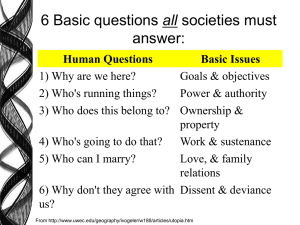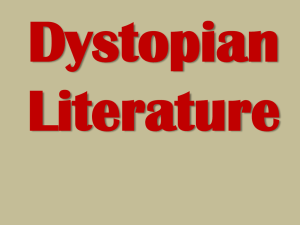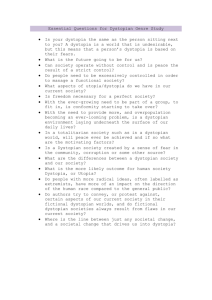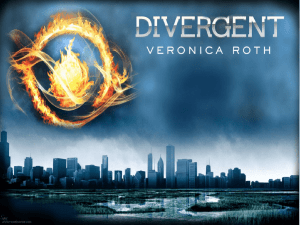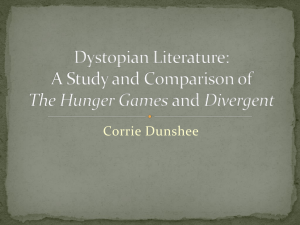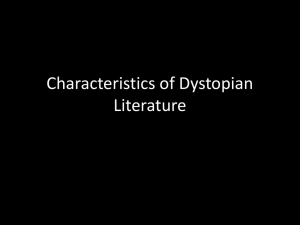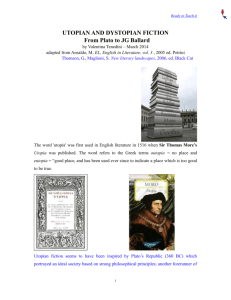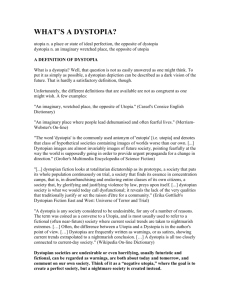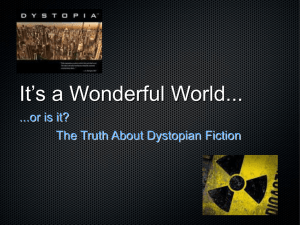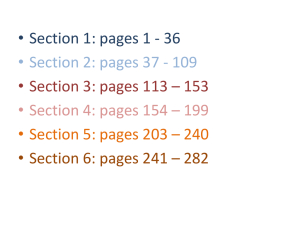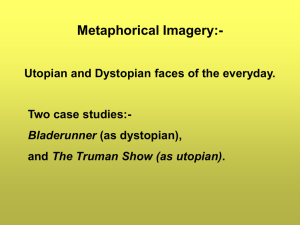Lecture 6 Dystopian Visions
advertisement
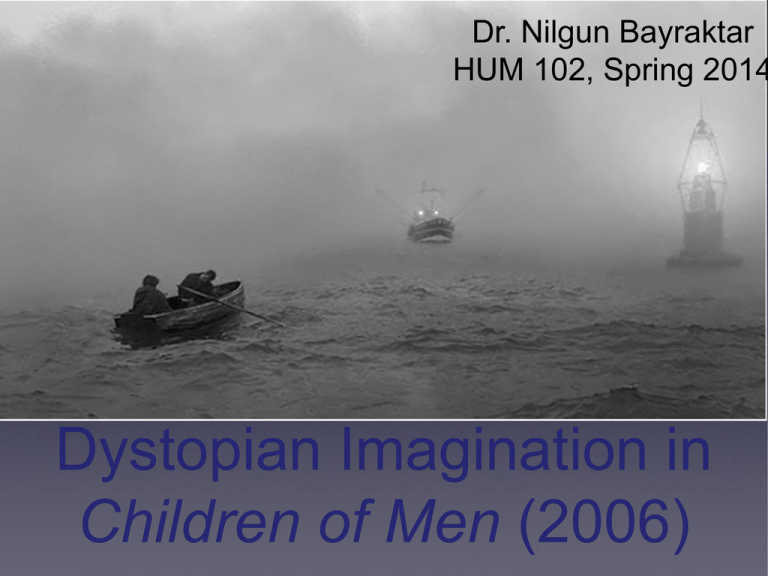
Dr. Nilgun Bayraktar HUM 102, Spring 2014 Dystopian Imagination in Children of Men (2006) Dystopia=dys-[u]topia • First recorded use by the British philosopher John Stuart Mill in 1868 • Dys: Greek dus: bad, abnormal, diseased • topos: place • “An imagined place or state in which everything is unpleasant or bad, typically a totalitarian or environmentally degraded one. The opposite of Utopia” (Oxford English Dictionary) • Dystopian elements in Utopia? • Utopian impulse or desire in Dystopia? Gulliver's Travels (1716) by Jonathan Swift direct response to the utopian visions of early scientific thinkers such as Francis Bacon traditional utopian model • Plato’s Republic (380 BC) and Thomas More’s Utopia (1516) are primarily centralist and authoritarian in orientation • A dream of order in a world of disorder Dystopia in the 20th century • “Dystopian narrative is largely the product of the terrors of the twentieth century. A hundred years of exploitation, repression, state violence, war, genocide, disease, famine, depression, debt, and the steady weakening of humanity through the buying and selling of everyday life provided more than enough fertile ground for this fictive underside of the utopian imagination” (Tom Moylan, Scraps of Untainted Sky, xi) dystopian imagination • the idea of totalitarianism • the idea of scientific and technological progress (used in the establishment of dictatorships) problem of definition dystopia: anti-utopia? • anti-utopia: directed against Utopia and utopian thought; refuses all utopian hope and effort. • dystopia: works not to undermine Utopia, but rather to make room for its reconsideration and re-functioning in even the worst times. classical form of dystopia • E. M. Forster’s “The Machine Stops” (1909) • Yevgeny Zamyatin’s We (1924) • Aldous Huxley’s Brave New World (1932) • George Orwell’s Nineteen Eighty-Four (1949) • Ray Bradbury’s Fahrenheit 451 (1953) • Margaret Atwood’s The Handmaid’s Tale (1986) Zamyatin’s We (1924) • A critique and a warning of the Stalinist totalitarian regime’s potential. • Anxieties, fear and disappointment with the Russian Revolution and the new utopian society it was supposed to bring. Huxley’s Brave New World (1932) • • • satirizes capitalism, bourgeois society, and an all-powerful totalitarian state at what human cost social stability is attained how what appears to be a perfect utopian paradise--at first glance--can turn into a hellish dystopian nightmare Orwell’s Nineteen Eighty-Four (1949) • • society under a brutal dictatorship with secret surveillance, never-ending wars and horrible living conditions individuality is considered a thought crime and people live in constant fear and misery dystopia in utopia • These (classical) dystopian works describe and warn against utopias that at first appear to offer a perfect life with ideal governmental organization and living conditions, but later start to reveal its ugly dystopian face. dystopian film • Metropolis (1927) by Fritz Lang • Alphaville (1965) by Jean Luc Godard • THX 1138 (1971) by George Lucas • Blade Runner (1982) by Ridley Scott • Brazil (1985) by Terry Gilliam • The Matrix (1999) by Watchowski Brothers • V for Vendetta (2005) by James McTeigue Metropolis (1927) by Lang • • • Silent film set in the year 2000 in a futuristic city Depicts a dehumanized urban population enslaved to the machines they tend under the rule of a tyrant Very important for its striking visual images of modern anxiety over technology and urbanization THX 1138 (1971) • depicts a dystopian future in which the populace is controlled through android police officers and mandatory use of drugs that suppress emotion, including sexual desire The Matrix (1999) • Portrays an illusory, constructed reality that is inhabited by people who are deliberately kept unaware of the artificial nature of their world humans as batteries for machines Alfonso Cuarón’s Children of Men (2006) Children of Men • dystopian science fiction film • set in 2027 • portrays a bleak future after the nuclear and environmental destruction of the entire world outside of Britain • imagines a future world where human reproduction is no longer possible • • • • • Visualizing the Dystopian Present Children of Men as a “critical dystopia” of our present Its vision of the future is linked to contemporary political, economic, and environmental concerns. Numerous references to contemporary geopolitics A dense network of high-culture and popular cultural citations It offers a critique of post-9/11 global politics as well as a meditation on cinematic aesthetics. the central thematic elements • self-reflexive emphasis on an omnipresent media in the global age • military violence and anonymous terrorism • a nationalist, totalitarian state and xenophobia • a disastrous biological and ecological reality cinematic techniques • borrowing from or referencing to contemporary social and political themes and visual images/symbols • an utterly realist style achieved by the use of long takes and hand-held camera • wide-shots that activate the background • reversal of the background/foreground in the world of the film Cinematic Technique I: References to contemporary reality • Post 9/11 era • “War on terror” • Abu Ghraib prison • Guantanamo Bay detention camp • Severe immigration laws (militarization of borders) • Ecological disasters Dystopian future is now! • “Unlike the traditional utopia, dystopian fiction posits a society which is clearly extrapolated (derived) from that which exists. Where utopian fiction stresses the difference of the society it depicts ... the dystopian writer (filmmaker) presents the nightmare future as a possible destination of present society” (Chris Ferns, Narrating Utopia) Cinematic Technique II: Widescreen Activating the background • The camera constantly asks the viewer to look beyond the plot’s white male protagonist (Theo), who is blind to the disturbing images of police violence and social unrest that occupy the dynamic backdrop of the film. • Long, wide-shot takes constantly frame the characters against an equally detailed and significant environment. Billboard: “Avoiding Infertility Test is a Crime” Billboard: “Suspicious?” “Report it!” Picasso’s Guernica The Arc of the Arts Guernica in the background Guernica in the foreground References to Abu Ghraib prison and Guantanamo Bay Cinematic Technique III: Long Take The Illusion of an unmediated Reality • The long takes, such as the opening explosion, make the viewer believe the movie was shot in real time (when actually these scenes were shot over several days). • Similar to documentary footage or a newscast clip: long-take Hope? • Is there any possibility for hope in a dystopian world? • Is there any possibility to escape the oppressive political, social, and cultural tyranny of the dystopian future? • Would such an escape institute a Utopian turn (or return)? Critical Dystopia • Children of Men can be defined as a critical dystopia. • The film “offers new Utopian trajectories against a seemingly overwhelming world system that is striving to achieve its historical goal of total external and internal exploitation of humanity and nature” (Moylan, Scraps of the Untainted Sky,105). Is Utopian kinship possible? • The Utopian kinship that emerges in the film replaces blood ties with collectivity • This voluntary kinship leads to a subject who can show us a radical new potential for the human Human Project: Utopian desire? The boat Tomorrow Utopia: undefined, unknown
